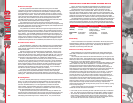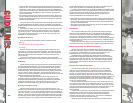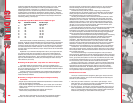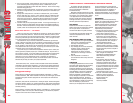
fitness and improved performance and add more energy to your life. "Most
training programs use a combination of training intensities to increase
performance capacity," according to J. T. Kearney, Ph.D., Senior Exercise
Physiologist at the U. S. Olympic Training Center in Colorado Springs. Kearney
suggests that it is important for individuals to monitor intensity. "There are
many different ways to monitor training but monitoring heart rate response is
the simplest, most convenient and least expensive physiological method for
monitoring training," Kearney says.
■ Predicted Target Heart Rate Zones for Different Ages
Age Maximum Predicted Aerobic Target
Heart Rate Zone: 60-85 %
20 200 120-170
25 195 117-166
30 190 114-162
35 185 111-157
40 180 108-153
45 175 105-149
50 170 102-145
55 165 99-140
60 160 96-136
After several weeks of "aerobic conditioning," certain changes become
apparent. What was a barely attainable level of exercise before, now becomes
quite easy. Whereas cycling or running at a certain pace or speed may have
previously caused your heart rate to go up to 135 beats per minute, that pace
can now be achieved at a lower heart rate. In short, your heart is becoming
stronger, larger and more efficient, and your body is able to do the same work
with less strain.
Regardless of your maximum average heart rate or your target heart rate,
you should consult with your physician or with a sports medical expert to
establish, with precision, the rates that are right for you, your age and your
medical and physical condition. This is especially important if you are over the
age of 35, been sedentary for several years, overweight or have a history of
heart disease in your family.
■ Beating The Dropout Odds: Jump Start Your Fitness Program
You already know you need to exercise. And you're probably trying –
at least a little. But let's get serious: If you don't add regular exercise to your
life, you're missing out on a sure bet. This is one area where medical research
all points in the same direction.
"Starting to exercise is comparable, from a health benefit standpoint, to
quitting smoking," says the recently released Surgeon's General Report on
Physical Activity and Health.
■ Summary of Surgeon General’s Report on Physical Activity
and Health:
• Regular physical activity offers substantial improvements in health and well-
being for the majority of Americans.
• If you exercise regularly, the reports show, you'll reduce your risk of heart
attack, cancer, diabetes, high blood pressure, osteoporosis, and even the
common cold.
• Regular exercise, regardless of the intensity, can help you
control stress, sleep problems, and depression.
But even with all this evidence, only 22 percent of Americans engage in
exercise for 20 minutes a day. And even among individuals who begin
exercise programs, the dropout rate is about 50 percent. So if the Surgeon
General's findings are not convincing evidence enough to keep most us
exercising on a consistent basis, what is?
Scientists are finding that the process of beginning, increasing and
ultimately sticking to an exercise program is a combination of two elements:
finding the right incentives and building a habit. And, as we will see, these
two motivational factors are connected, but distinct.
Focusing on the positive is one of the best incentives to exercise. Avoid
looking at exercise as a way to fix something that's wrong with your body.
Instead, focus on your successes. Pat yourself on the back each time you've
made it though a workout. Thrive on the energy that exercising gives you.
Reward yourself with a dinner out, after you have reached a certain weight
loss goal, or buy yourself a new workout outfit. With these rewards, you'll
go back for more, and your body will show results.
Don't view exercise as punishment. Don't look at exercise as something that
has to be tackled because you are out of shape. Think of exercise as an
investment in your health, your physical looks and your mental outlook. As you
run, walk or lift weights, concentrate on the positive energy being generated
within your body and the renewed sense of life and wellness you feel.
The basics of any fitness program are planning and setting goals. Goal setting
and formulating a plan are the most clear ways of establishing a consistent
program of exercise; they are also a powerful form of direction and
motivation. Take some time to think about what will help you begin your
exercise program. Write these down in your daily planner or diary. Goals
provide a sense of purpose and incentive that can drive you to your intended
destination. However, for goals to be effective they need to be realistic.
Motivation will be strengthened only if it's possible to reach your objectives.
Consider this: Your mind and body will respond better to exercise if you
start with 20-minute sessions, three times a week, rather than an hour session
four times per week. Once the sessions become a routine, aim for 30 minutes,
then increase from there.
The most important thing in any exercise program is to do your best to
keep progressing, backsliding as little as possible and getting back on the horse
just as fast as possible if you fall off. Try to anticipate lapses: If a crazy workday
looms, get up early and squeeze in a short ride on a stationary bicycle so that
you've achieved something even if it isn't your regular workout routine. When
on a business trip, stay in a hotel that has an onsite workout facility.
Exercise is one of life's joys. It energizes – giving you a sense of well-being
and accomplishment and keeps you healthy and fit. There is great pleasure in
being able to set goals, accept challenges, and push yourself to a better
lifestyle of health and fitness. No matter what your reason for exercising –
to lose weight, to get fit, or to feel better –- motivating yourself to exercise
on a regular basis requires changing your behavior.
■ Make Exercise A Habit
The key to a successful fitness program is getting your body to do what
your mind knows it should. Here are six mental strategies to help keep you
focused on your fitness goals.
1. Clarify why you want to exercise. If you want to gain strength – is it to
swim more laps, or to tone-up your body. By understanding and detailing
your goals, you will be better able to stay motivated.
2. Vary your workout. To make your routine more enjoyable, vary it once in a
while. Supplement your indoor cycling with outdoor cycling and strength
training. These activities make exercise more interesting and increase your
fitness level by making you utilize different muscle groups.
1918














